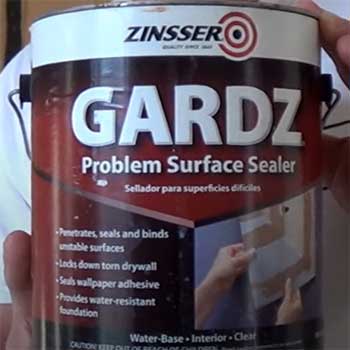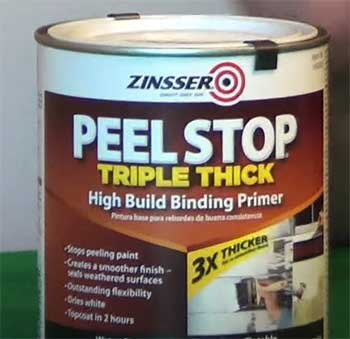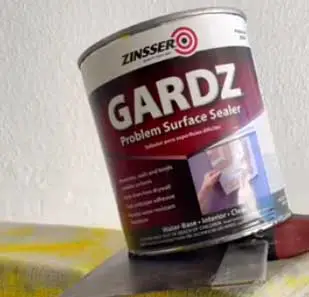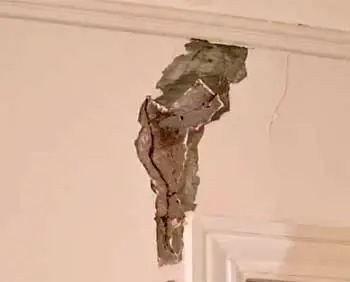Are you looking for a surface sealer?
If so, I have two of the best products for you Peel Stop and Gradz. They are compared because of their high-performance sealing.
But how to choose between them? This article will give you a clear idea of Peel stop vs. Gradz.
Both products are manufactured by Zinsser, a leading manufacturer of primer, sealer, and many other products based in the USA. I will discuss their features and compare them so that you can decide between these two sealers.
A Quick Comparison Table Between Peel Stop And Gardz
Here’s a quick comparison table between these two sealers:
| Aspects | Peel Stop | Gardz |
| Usage | Sealing and Coating | Sealing and Coating |
| Key Feature | Recoat in 2 hours | Recoat in 3 hours |
| Benefits | Interior and Exterior Use | Works on high-pH surfaces |
| Application | Coverage: 7.4-9.8m2 per liter Touch dry: 1 hour Full Cure: 7 – 10 days Recoatable: 2 hours | Coverage: 5-10m2 per Liter Touch dry: 30 minutes Full Cure: 3 days Recoatable: 3 hours |
| Pack Sizes | 1L, 2.5L, and 5L | 500ml, 1L, 2.5L, and 5L |
| Color | Transparent | Transparent |
| Price | $40.15 | $28.73 |
Key Differences Between Peel Stop & Gardz

Peel Stop is a cleaner and flexible bridging sealer. You can use this product on surfaces where dusting, chalking, peeling, and flaking are hard.
More importantly, you can use it on both interior and exterior surfaces. It creates a breathable membrane over faulted substrates.
On the other hand, Gardz is a water-based unique porous and potential problem surface sealer.
It is designed to penetrate deep and becomes a hard moisture resistant film when dries.
You can seal and binds down porous and crumbling surfaces with this sealer.
- Usage
Peel Stop glues down edges of the old coating. It will seal and bridge any cracking and checking. Apart from that, this high-performing sealer will blind chalky surfaces.
Similarly, Gardz penetrates deeply into porous surfaces and dries fast to a hard, moisture-proof film. It prevents walls from drywall blistering and blinding down chalky surfaces.
Besides, it seals in residual wallpaper paste and strengthens soft texture finishes. So we can see there are some similarities and differences in usages between these sealers.
- Key Features
Peel Stop is a clear bridging sealer that extends the life of a problem surface. It glues down cracks and gaps from under old paints. With it, you can recoat in two hours.
You can make it cleans up with water and soap. More importantly, you can use this sealer on interior and exterior surfaces.
On the other hand, Gardz is a water-based, clear sealer that repairs torn papers from damaged drywall and eliminates bubbles. It seals off any wallpaper adhesive.
This water-based sealer is a low odor and becomes transparent when dries. It also cleans up with soap and water.
- Benefits

Peel Stop and Gardz bear a lot of benefits. For example, Peel stop is a highly flexible and breathable sealer.
It removes any stains of old wallpaper. Plus you can recoat it in 2 hours.
But the essential benefit that the other does not provide is you can use it on both interior and exterior surfaces.
Looking at Gardz, we will see a low odor, water-based, transparent sealer. You can apply it to high-pH surfaces.
It dries fast and becomes hard and moisture-free films. Plus, you can clean it up with just water and soap.
- Application
Peel stop cover 7.4 to 9.8 m2 per liter. Its touch dry duration is 1 hour and will take 7 to 10 days for a complete cure, and you can recoat it in 2 hours.
In contrast, Gardz covers 5 to 10 m2 per liter. Its touch dry duration is only 30 minutes and takes 3 days to cure fully. But it becomes ready to recoat in 3 hours.
Here we see that peel cover provides maximum coverage takes less time to recoat. But Gardz takes less time to become touch dry and fully cure.
- Pack Sizes
Pack or container sizes can make a difference between Peel stop and Gardz. You might want to have more size options according to your need. Peel stop comes in 3 different sizes: 1L, 2.5L, and 5L containers.
On the other hand, Gardz has 4 sizes: 500 ml, 1L, 2.5L, and 5L. Gardz offers more size options than its counterpart Peel stop.
- Color
There is nothing much difference between Peel stop and Gardz regarding color. Both become transparent when dry. Peel stop becomes transparent membrane over faulted surfaces when dries. But Gardz becomes moisture-resistant films when dries.
Peel Stop is a low odor flexible bridging sealer, whereas Gardz is a water-based, low odor sealer. Although they serve a similar purpose, their way is different.
- Price
Like many other things, Peel stop and Gardz differ in price as well. A 1-gallon Peel Stop container will cost you $40.15, and a 5-gallon container will cost around $168.
On the contrary, 1 gallon of Gardz will cost about $28.73, and the same sealer will cost around $119 for a 5-gallon container.
It is now evident that Peel stop is way more expensive than Gardz. It is because it covers more areas and takes less time to recoat.
An Ugly Situation Calls For Peel Stop
Many a homeowner has experienced the frustration of peeling paint. It often starts innocently enough—a small nick here, a bubble there. But before you know it, noticeable chunks of paint start curling up off the surface like pencil shavings.
This peeling action indicates that multiple layers of old paint have not properly bonded together over time. So the paint essentially has no grip and loses adhesion. Once peeling starts, it tends to accelerate quickly across your siding, trim, or interior walls.
This is where Peel Stop shines. It is specially formulated to seal in flaking paint layers and stop the peeling progression in its tracks. Simply use an abrasive pad to feather any loose paint edges, then brush or roll on Peel Stop primer right over the problem area—without completely stripping down to bare wood. The thick primer soaks into and reinforces delicate paint layers, literally gluing everything back down firmly so you can repaint without worries.
Peel Stop has relatively low odor for a convenient water-based formula. It goes on pink so you can easily see primed areas for full coverage. And it dries fast to a solid off-white, ready for nearly any type of topcoat within an hour.
So if you have surfaces plagued by cracking, curling, flaking or generally unstable paint—especially exterior areas exposed to sun and weathering—Peel Stop offers a foolproof solution for securing finicky paint so it stops peeling.
Rough And Tough Jobs Call For Gardz

While Peel Stop focuses on keeping existing paint stuck tightly, Gardz handles a wider range of compromised surfaces.
Its forte is sealing porous, powdery, damaged and generally problematic substrates to create an ideal smooth base for paint adhesion.
Many builders use Gardz primer religiously because it has amazing penetration power even with challenging finishes.
Some specific scenarios where Gardz outperforms other primers:
- New Drywall & Plaster. Fresh drywall is highly absorbent and plaster can be quite powdery. Unprimed, walls will suck the moisture out of paint unevenly. Gardz soaks deeply into the substrate to seal, harden, and equalize porosity differences. Paint then glides smoothly without flaws.
- Repair Patches and Spots. When you fill nail holes, spackle, or skim coat repairs, the new dry patching compound is also very porous compared to surrounding surfaces. Gardz binds everything evenly so repairs blend in seamlessly when painted.
- Damaged Gypsum or Plaster Walls. Gardz goes deep into cracked or soft plaster, hardening it while also allowing flexibility without cracking further. Your walls become rock solid for renewed paint durability.
- Chalky Exterior Surfaces. Over time, sun exposure can cause exterior paints to oxidize into porous, powdery chalk. Brushing or spraying Gardz will re-solidify the surface so new paint stays vibrant.
- Stains and Tannin Bleed. Gardz blocks stains and seals porous areas prone to tannin bleed, ensuring they don’t resurface and ruin a nice new paint job.
In all these cases, Gardz will soak in up to three times deeper than standard primers for a superior base. It dries fast and crystal clear regardless of how much you apply. New paint is less likely to fail or leak moisture with Gardz underneath.
Some users complain of Gardz’ strong ammonia smell during application. Ventilation is key, along with safety precautions to avoid inhaling fumes. Once dry and sealed with paint, there is no lingering odor. For the ultimate seal on troublesome surfaces, Gardz industrial-strength penetration can’t be beat.
Which One Is Suitable For You?

Peel Stop is a low-odor, transparent flexible bridge sealer that becomes a breathable membrane when dries.
It covers 7.4 to 9.8 m2 per liter and takes one hour to become touch dry and 7 to 10 days for a complete cure.
You can recoat it in 2 hours, and it is more expensive than its counterpart. But you can use it indoors and outdoors.
Gardz is a water-based low-odor transparent sealer and becomes a moisture-resistant film when dries.
It covers 5 to 10 m2 per liter and takes only 30 minutes to become touch dry and only 3 days to become fully cured.
You can recoat it in 3 hours, and it costs way less than Peel stop.
Now that you have all the facts in place, it cannot get easier to choose the right one for your need. But I would suggest Peel Stop. It is expensive, but it covers more space, and you can use it both indoors and outdoor.
Here is a handy guide for when to choose Peel Stop vs Gardz based on your specific situation:
Peel Stop Is Best For:
- Stopping existing paint from peeling or flaking
- Sealing cracks in worn paint layers
- Prepping exterior surfaces showing signs of paint failure
- Locking down delicate historic paint finishes
- Covering glossy enamels or difficult existing coatings
- Quickly sealing and reinforcing bad paint jobs
- Topcoating with either latex or oil/alkyd paints
Gardz Is Best For:
- Sealing NEW powdery or porous surfaces (fresh drywall, plaster, patch compounds, wood filler, etc)
- Building an even base on repaired/damaged wall areas
- Priming heavily chalked or oxidized exterior surfaces
- Blocking stains, tannins, rust, grease, smoke, graffiti
- Reinforcing cracked/damaged plaster or drywall
- Spray application over large commercial/industrial spaces
- Topcoating with latex paints only (no oils)
Frequently Asked Questions (FAQ)
Peel Stop is a transparent and flexible bridge sealer for peeling, flaking, and chalking surfaces. You can use it on interior and exterior surfaces.
Zinsser Peel Stop seals over faulted surfaces. It creates a breathable low-odor membrane over faulted substrates. It seals and bridges cracking and checking on surfaces.
Yes, Peel Stop is a transparent and flexible binding primer. It is designed for sealing peeling, cracking, and chalking surfaces. You can use it over paint.
Peel Stop is an excellent sealer that works on cracking, peeling, and chalking surfaces to seal them and prevent them from getting worse. You can also use it as a primer.
Conclusion
Peeling and flaking wall or drywall blistering can become your biggest nightmare. It can make your life more difficult. So, seal the minor faults and do not let them worsen.
Most importantly, use a good sealer. I hope my Peel stop vs. Gradz review comes in handy for you. So, it’s time you purchase the right sealer and renovate your faulty walls.
